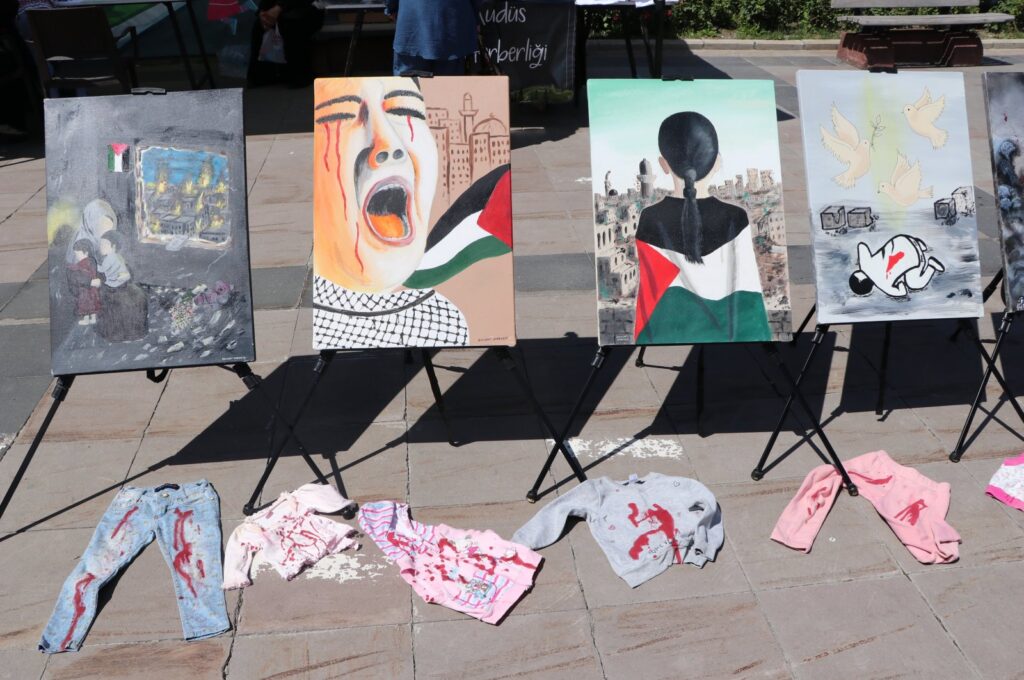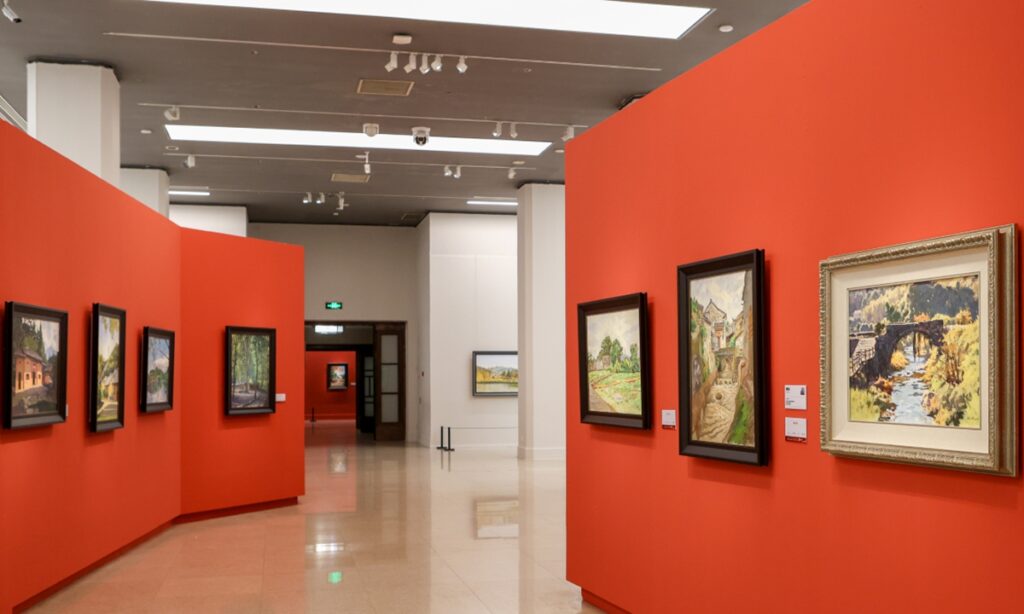
Maghie Ghali
In a first for Saudi Arabia, the King Abdulaziz Center for World Culture, also known as Ithra, has opened a retrospective exhibition of the internationally acclaimed late Lebanese-American artist, poet and writer Etel Adnan.
Showcasing 41 works across a range of mediums, Between East and West is curated by former Lille Metropole Musee director Sebastien Delot. It traverses Adnan’s creative journey over her lifetime, from the very beginnings of her career in the 1950s to her final creations in 2021. Adnam died in 2021 at the age of 96.
Made possible by loans from Sharjah Art Foundation and Lebanon’s Sfeir-Semler Gallery and Sursock Museum, as well as private collectors, the exhibition delves into Adnam’s multifaceted practice, influenced by her multicultural upbringing, eye-opening encounters with other creatives around the world and a need to ground her own complex identity during a time of global change.
“Etel was born in Lebanon but her father was born in the time of the Ottoman Empire. His family was coming from Damascus and her mother was from Cyprus,” Delot tells The National.
“When they first met each other they were living in Smyrna, which is Izmir today in Turkey, and after the Dardanelle conflicts and the First World War, when the Ottoman Empire collapsed, the family left, because the father was a soldier, a high-ranking officer, and it became difficult for mixed marriages to remain.
:quality(70)/cloudfront-eu-central-1.images.arcpublishing.com/thenational/DF7WA6VFQBFV7ENTPAOWZNVWLA.jpg?w=810&ssl=1)
“Eventually they went to Lebanon, where they settled down, and in 1925 Etel was born. So the idea of between East and West is because she was born in between languages, in between different cultures, and in between different times, because her father was an Ottoman man of the 19th century and Lebanon had become a French protectorate – they didn’t speak Arabic, but they wrote to each other in French.”
This context she was born into would inform her work for the rest of her life. Adnan longed to connect with the Arabic language, which she explored by turning the language into visual symbols, painting in Arabic as she could not write in it.
In the 1950s, she received a scholarship to Paris, where she met many artists, writers and philosophers, all of whom opened her mind to new ideas and forms of creative expression, such as Gabriel Bounoure and Andre Gide.
Adnan has now become well-known for her blend of Arabic calligraphy and poetry within her artworks, most noticeably in her Leporellos – an accordion-style art book of Japanese origin – where she painted visual interpretations of poems by great contemporary Arab poets. One of these fragile artworks is on show at the exhibition.
:quality(70)/cloudfront-eu-central-1.images.arcpublishing.com/thenational/4RDFMZSOAJG3DKNR35XCIQ3JNM.JPG?w=810&ssl=1)
“It’s a small exhibition, so we couldn’t go into every aspect of her work in great detail, but we wanted to give a compass to the public to understand her relationship to literature, and how much calligraphy was important to her,” Delot says.
“She felt she was rejected by Arab poets, and she really wanted to connect with the language. She started copying some of the great Arabic poetry, to be part of it, and then wrote her own poetry in Lebanon, as a young student.
“Then she first published Moonshots (her book of poetry) in 1966 when she was in America, living in California,” he adds. “If you look at Arab Apocalypse (another book published in 1980), you have all these symbols on the pages and it becomes like a musical score or some kind of notations. She had visual signs that she invented that would take over the voice when she became speechless about a situation.”
These symbols were also prevalent in her artwork – a kind of glyphic alphabet that would also pop up in her Leporellos. In her abstract paintings and tapestries, images of the sun, mountains and vast landscapes reigned, rendered in patches of vibrant hues often left as undiluted block colours.
:quality(70)/cloudfront-eu-central-1.images.arcpublishing.com/thenational/42RF2HH6NBHCZIAEHOSCXUP73Y.tiff)
This can be seen best in her painting Mount Tamalpais (1985), one of the exhibition’s highlight pieces on loan from Sursock Museum. It stands out due its large size and theme of the mountain, painted in soothing yet unusual tones of dusty pinks and peaches, lilac and pea green, shadowed by an ultramarine blue sky.
“She had a big focus on nature and the landscape, which she also saw as a political thing, because it’s a result of centuries of mankind transforming the world around us,” Delot says. “Even behind the colours, or when painting an aggressive red sun, it could be both a symbol of destruction, but also a symbol of life. She always had layers of meaning and sometimes even contradictions.
“She was living in California for many decades and she was impressed with Mount Tamalpais, but at the same time in Lebanon, the mountains were never very far from view, so her paintings of mountains are always a mix of different things she’d seen,” he adds. “Also the colours she used in this painting are a bit unusual. It seems almost childish in the way it’s painted, but it’s vibrant. It’s really incredible.”
:quality(70)/cloudfront-eu-central-1.images.arcpublishing.com/thenational/UZ7ZXQSDZZGANJEIBOYAFVCVDA.jpg?w=810&ssl=1)
Other highlights of the show include a 25 sqm ceramic mural – part of Ithra’s permanent collection – and a screening of Motion, a montage of several Super 8 films made by Adnan in Yosemite, New York and San Francisco in the 1980s.
Alongside a variety of oil and watercolour pieces, the exhibit also includes several examples of Adnan’s hand-woven wool tapestries, inspired by Persian rugs of her childhood and the Arab tradition of woven craft, intersecting with the weaving styles she discovered in her travels to Mexico and Egypt.
“She was impressed when she travelled to Harraniya, the weaving village in Egypt, because it was a completely different field of tapestry, which was not intellectualised – there were no drawings that were precedent to the designs,” Delot explains. “It was really weaving out of the observation of nature, and that was really something that interested her.
“In California she met Ida Grae, a tapestry artist who would dye the wool with natural pigments, which to Etel was like capturing the essence of nature, to use in the artwork,” he adds. “Even in the late Leporellos, Etel would use fruits to make colours. For example, she has this distinctive pink she used and I know she made it from natural pigments.”
:quality(70)/cloudfront-eu-central-1.images.arcpublishing.com/thenational/QLH6TJTETRGW3JZPJYH7YYQ4CM.jpg?w=810&ssl=1)
With colour being such an integral part of her practice, she experimented with drawing natural pigments from onion skins, red cabbage and pomegranate. Similar to her paintings, the tapestries allude to landscapes and natural motifs – some of the tapestries shown in the exhibit were created mere months before she died, having spent her life in perpetual creativity.
Most notably, the exhibition presents the fluidity and curiosity of Adnan’s artistic practice, which innately stemmed from her desire to devise a universal visual language that balanced the many facets of her identity, without needing to define her expression through any one meaning or medium.
The exhibition’s catalogue, published by Hatje Cantz in both Arabic and English, will feature contributions from Delot, alongside art historian, writer and poet Toni Maraini, and art historian, publisher and curator Morad Montazami. The text intends to delve deeper into Adnan’s life and career, which was as vibrant and complex as her brightly coloured canvasses.
Courtesy: thenationalnews








